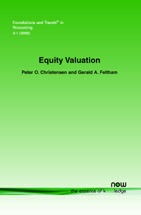Equity Valuation
By Peter O. Christensen, School of Economics and Management, Aarhus University, Denmark, pochristensen@econ.au.dk | Gerald A. Feltham, Sauder School of Business, University of British Columbia, Canada, gfeltham@shaw.ca
Abstract
We review and critically examine the standard approach to equity valuation using a constant risk-adjusted cost of capital, and we develop a new valuation approach discounting risk-adjusted fundamentals, such as expected free cash flows and residual operating income, using nominal zero-coupon interest rates. We show that standard estimates of the cost of capital, based on historical stock returns, are likely to be a significantly biased measure of the firm's cost of capital, but also that the bias is almost impossible to quantify empirically. The new approach recognizes that, in practice, interest rates, expected equity returns, and inflation rates are all stochastic. We explicitly characterize the risk-adjustments to the fundamentals in an equilibrium setting. We show how the term structure of risk-adjustments depends on both the time-series properties of the free cash flows and the accounting policy. Growth, persistence, and mean reversion of residual operating income created by competition in the product markets or by the accounting policy are key determinants of the term structure of risk-adjustments.
Equity Valuation
Equity Valuation reviews and critically examines the standard approach to equity valuation using a constant risk-adjusted cost of capital and develops a new valuation approach discounting risk-adjusted fundamentals using nominal zero-coupon interest rates.
Equity Valuation is organized as follows: Chapter 2 (Risk-adjusted Discount Rates) reviews standard valuation models based on risk-adjusted discount rates. Chapter 3 (Multi-period Asset Pricing Theory and Accounting Relations) examines key results from multi-period asset pricing theory in discrete-time, and shows how equity valuation models can equivalently be based on free cash flows or accrual accounting numbers. Based on these results, the authors derive an accounting-based multi-period equity valuation model presented in Chapter 4 (An Accounting-based Multi-period Equity Valuation Model) with equilibrium risk-adjustments determined by prices of aggregate consumption claims. Chapter 5 (Equity Valuation with HARA Utility) includes a general equilibrium analysis of a setting in which the investors have HARA utility, and aggregate consumption and residual operating income are jointly normally distributed. A set of appendices follows including Appendix B that extends the setting to preferences with external habit formation (which recently has gained popularity in asset pricing theory), and Appendix C, which discusses the relationship between risk-adjusted expected cash flows and certainty equivalents.
